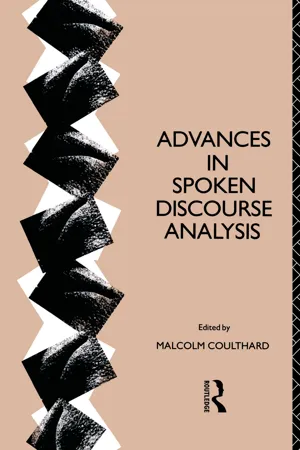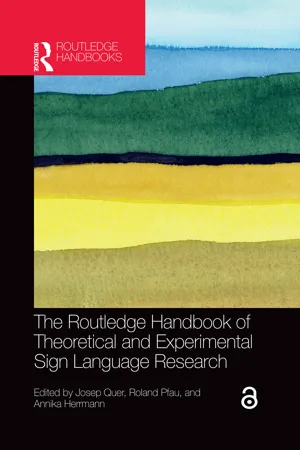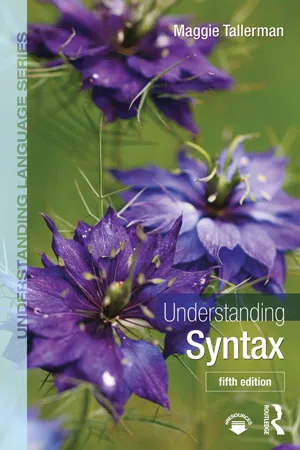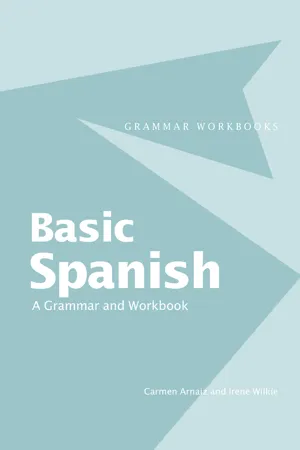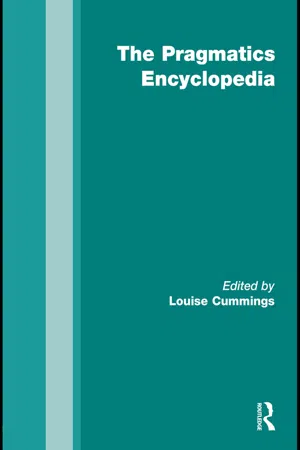Interrogatives
Interrogatives are a type of word or phrase used to form questions in a language. They typically include words like "who," "what," "where," "when," "why," and "how." In linguistics, interrogatives are studied for their syntactic and semantic properties, as well as their role in forming questions and seeking information.
5 Key excerpts on "Interrogatives"
- eBook - ePub
- Malcolm Coulthard(Author)
- 2013(Publication Date)
- Routledge(Publisher)
...5 A functional description of questions Amy Tsui INTRODUCTION The term ‘question’ has been used in the linguistic and speech act literature as though it is generally understood what a ‘question’ is. Unfortunately, an examination of the studies on ‘questions’ shows that the term has never been clearly defined. It has been used as a semantic category (see Quirk et al. 1972, 1985), as an illocutionary act (see for example Lyons 1977, 1981; Huddleston 1984), and as a kind of ‘request’ or ‘directive’ (see for example Katz 1977; Katz and Postal 1964; Gordon and Lakoff 1975; Labov and Fanshel 1977; Burton 1980). Sometimes an utterance is identified as a ‘question’ because it is interrogative in form and sometimes because it expects an answer or some verbal performance from the addressee. In other words, the term ‘question’ is sometimes taken as a syntactic category and sometimes a discourse category; as a result, the term remains vague and ill-defined. In what follows, I shall examine some of the studies of ‘questions’. QUIRK et al.’s STUDY OF ‘QUESTIONS’ Let us start with the study of ‘questions’ by Quirk et al. (1972, 1985). 1 Quirk et al. define ‘questions’ as a semantic class which is primarily used to seek information on a specific point (1985:804)...
- Josep Quer, Roland Pfau, Annika Herrmann, Josep Quer, Roland Pfau, Annika Herrmann(Authors)
- 2021(Publication Date)
- Routledge(Publisher)
...11 Content Interrogatives Theoretical and experimental perspectives Meltem Kelepir 11.1 Introduction One of the most studied constructions in sign languages, and possibly one of the constructions that have raised the most controversy in sign language linguistics literature, is content Interrogatives. As the title suggests, this chapter aims to provide a survey of both theoretical and experimental questions that have been raised for this construction in sign languages. The first main section focuses on the theoretical issues regarding the syntactic analyses of the distribution of the interrogative (i.e., wh -) signs (henceforth, int-signs) and the functions of the non-manual markers in main and embedded content Interrogatives. The second main section presents the experimental studies that investigate the acquisition and processing of simplex content Interrogatives. 1 11.2 Theoretical perspectives Perhaps the most controversial issue in the theoretical discussions of content Interrogatives in sign languages has been the landing site of a moved int-sign and, related to that, the direction of the movement. Extensive typological and theoretical work on spoken languages has shown that, very roughly, languages can be categorized as wh -movement languages and wh -in-situ languages (putting aside a number of sub-categories for the moment) (Cheng 1991; i.a.). In an overwhelming majority of wh -movement languages studied so far, the interrogative word appears in the sentence-initial position, which has led generative linguists to argue that wh -movement is leftward to a left-branching [Spec, CP] (Chomsky 1977, 1986; Rizzi 1990; i.a.). Generally, it is assumed that this movement is triggered by the feature checking requirements of the [+wh] feature of both the interrogative word and C, the head of CP...
- eBook - ePub
- Maggie Tallerman(Author)
- 2019(Publication Date)
- Routledge(Publisher)
...9 Asking questions about syntax The title of this chapter is deliberately rather ambiguous. I am hopeful that by this point, you will be able to construct a basic syntactic description of a language, either a language that you speak well yourself, or one for which you can find a native speaker consultant. Section 9.1 outlines the kinds of questions that you will need to investigate. Section 9.2 provides a short case study of Welsh, illustrating how these questions could be answered. These sections, then, refer to asking questions about syntax in the most literal way. However, I also hope that the discussion in the previous chapters has ignited some curiosity about the human language faculty more generally. In Section 9.3, I briefly outline some issues and questions surrounding our syntactic abilities that are currently widely debated within linguistics. Section 9.4 looks at possible further directions to pursue in your study of syntax. 9.1 SYNTACTIC DESCRIPTION: WHAT QUESTIONS TO INVESTIGATE This section aims to give you a framework with which to write a basic syntactic description of a language that you know well, or for which you can access data readily. If appropriate, you can ask one or more native speakers to act as language consultant(s). Make sure you give the source(s) of your data, including attributions to the literature (i.e. cite your sources). Acknowledge any help given by language consultants. Give the name by which the language is known to its native speakers, plus its English name, if any. State its language family and the principal locations in which it is spoken. You will probably find various online resources very helpful indeed: Glottolog < http://glottolog.org >, Ethnologue < www.ethnologue.com > (Lewis et al...
- eBook - ePub
Basic Spanish
A Grammar and Workbook
- Carmen Arnaiz, Irene Wilkie(Authors)
- 2006(Publication Date)
- Routledge(Publisher)
...UNIT FIVE Interrogatives Forming a question in Spanish is quite straightforward. If a subject is expressed it is often placed after the verb: ¿Tienes tú las llaves? Do you have the keys? ¿Van ustedes a la fiesta? Are you going to the party? This is by no means obligatory, however, and you could also say: ¿Tú tienes las llaves? ¿Ustedes van a la fiesta? In the above examples the question looks just like a statement in the written form, but with the addition of the question marks. However, when spoken, the intonation indicates that a question is being asked. When there is no subject mentioned the fact that it is a question will be indicated by intonation alone: ¿Estudias mucho? Do you study a lot? ¿Estamos en el centro? Are we in the centre? Notice that an inverted question mark is put at the beginning of a question in written Spanish, even if the question is not the start of the sentence: Hoy es sábado, ¿quieres ir al cine? Today is Saturday, do you want to go to the cinema? Interrogative words The main interrogative words in Spanish are as follows: ¿cuál(es)? which?/what? ¿cómo? how? ¿cuándo? when? ¿cuánto(s)? how much/how many? ¿dónde? where? ¿por qué? why? ¿para qué? what for? ¿qué? what? ¿quién(es)? who? Note : These words always have a written accent when used as question words. You will have noticed that some of these words have feminine and plural forms, which means that they have to agree with the noun to which they refer: ¿Cuáles de los libros son tuyos? Which of the books are yours? ¿Cuántos hermanos tienes? How many brothers and sisters do you have? ¿Cuántas casas hay en la. calle? How many houses are there in the street? ¿Quiénes son los autores? Who are the authors? The personal a with ¿quién? When ¿quién? is used as the direct object (see ‘Glossary of grammatical terms’) of a verb, you must always put a before it, i.e. ¿a quién? : ¿A quién esperas? Who(m) are you waiting for? In this sentence, ‘you’ is the subject – i.e...
- eBook - ePub
- Louise Cummings(Author)
- 2010(Publication Date)
- Routledge(Publisher)
...We sincerely ask ourselves all kinds of questions when we are not our own addressees. We pose questions we know the answers to in order to examine the knowledge of some addressee. We pose questions we and our addressees know the answer to in order to create a rhetorical effect. Sometimes we pose a question we are sure our addressee cannot answer in order to teach the addressee some lesson. Thus, posing a question is a family of different speech act types, each of which is governed by a separate system of rules, both generally and in every natural language. Questions have been extensively studied as speech acts that play a role under special circumstances of interaction, such as interviews, interrogations and academic discussions (Crawford Camiciottoli 2008; Emmertsen 2007; Gnisci and Pontecorvo 2004). However, such studies shed light on the nature of these interactions more than on question as a speech act type. A study of brain localization of speech act types has revealed an intricate relationship between questions and requests (Soroker et al. 2005). ASA KASHER See also : Rhetorical question ; speech act theory ; speech act type Suggestions for further reading Chisholm, W.S. (ed.) (1984) Interrogativity: A Colloquium on the Grammar, Typology, and Pragmatics of Questions in Seven Diverse Languages, Amsterdam: John Benjamins. Searle, J.R. (1969) Speech Acts, Cambridge: Cambridge University Press. Somerville, J. (2002) The Epistemological Significance of the Interrogative, Aldershot: Ashgate. Quotation In its typical form a quotation is an iconic sign for a linguistic representation. Its main varieties are (1) metalinguistic citation, (2) direct quotation/speech, (3) mixed quotation and (4) scare quoting: (1) ‘Brussels’ rhymes with ‘muscles’. (2) Then she said, ‘Will you write a letter?’ and I said, ‘Sure’. (Hash 1999) (3) Quine says that quotation ‘…has a certain anomalous feature’. (Davidson 1979b: 28) (4) A boy tells Grossman of ‘his’ house in Jaffa...
